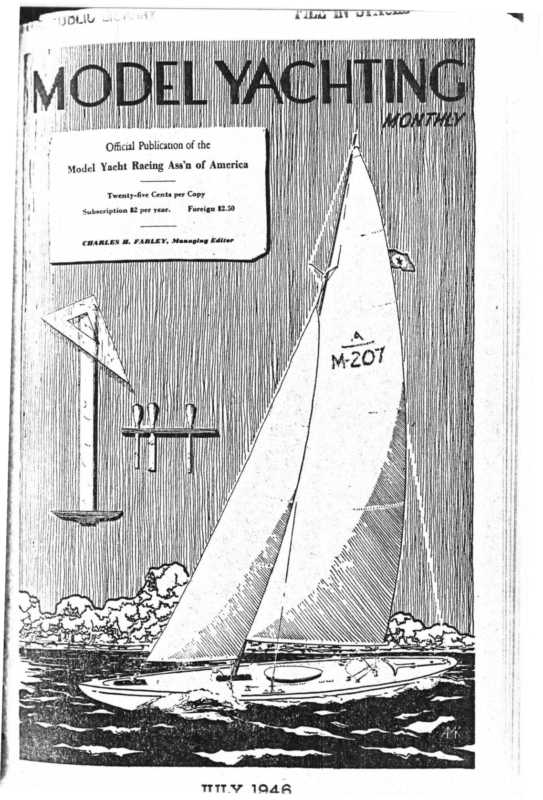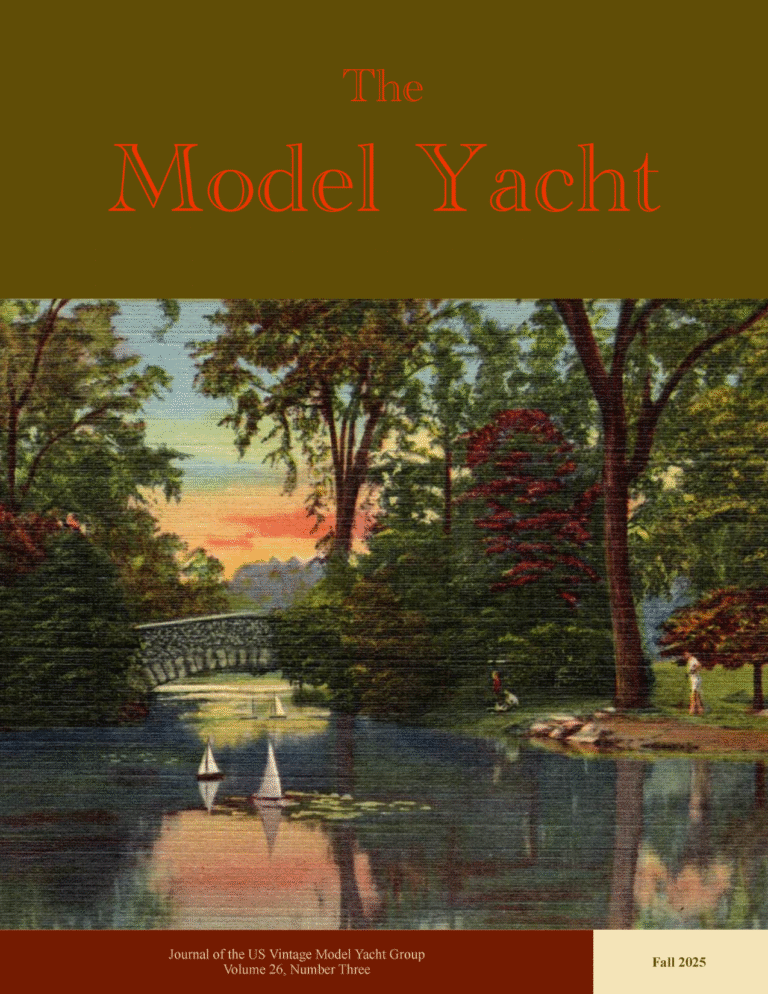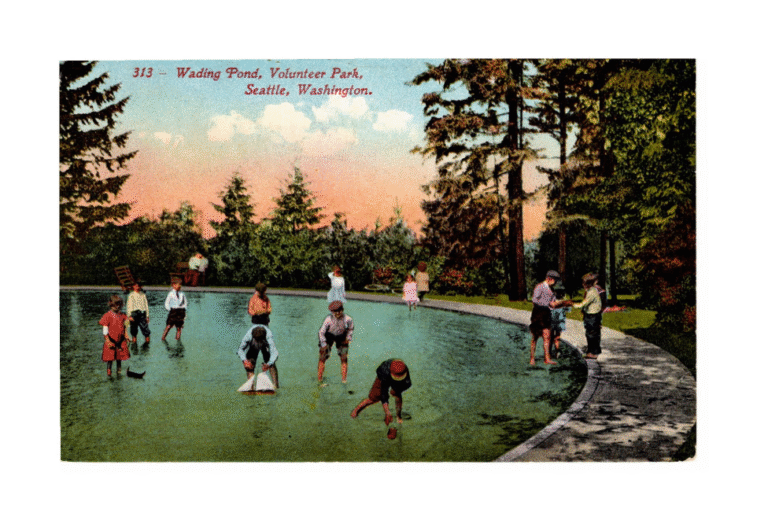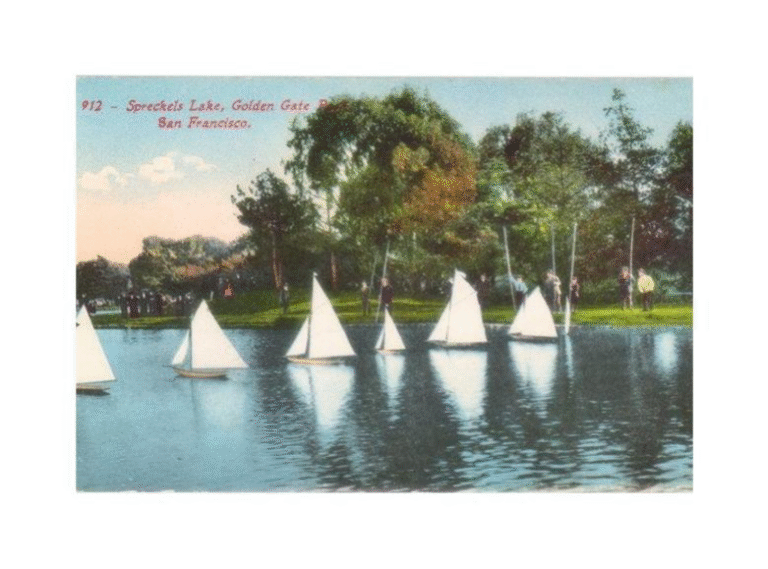- Technical Article Highlights
- Deck Construction Tips:
- Best material: 3-ply spruce or mahogany resin-bonded plywood (1/16″ thick).
- Avoid kiln-dried wood; air-dried preferred.
- Deck options: solid, planked, or simulated planking.
- Protection: varnish underside (4–5 coats), filler for open-grain woods.
- Fastening: brass brads recommended; toothpicks or screws optional.
- Design Elements:
- Covering board/planksheer: ~¾” wide, parallel to yacht sides.
- King plank: optional, for neat center joint.
- Rails: generally unnecessary for racing yachts.
- Decking Styles:
- Straight (nibbed or not), sprung, or herringbone.
- News & Updates
- Annual MYRAA meeting scheduled for August 10, 1946 in San Francisco.
- Clubs encouraged to submit articles, race reports, and photos for publication.
- Reports of new members and regattas in Eastern Division and Washington MYC.
- Tips & Advice
- Care of Sails:
- Ease lacing/jackstay to prevent distortion.
- Adjust outhauls in damp conditions; sails shrink when wet.

OfficwPublicauon of the , 11 ‘ ! I ;,I . ,I I • Model Yacht Rae·mga Assn , of Amer1ca . Twenty-five ~ub•crlption CB-tRLIES Ce n t • per Copy S2 per year. ,,. L/EI-‘. • M•••• B • …,.R r oreiga $2.SO 1••Elllter .~ ….,._…, ..,…..-r ‘ ~rzo·t …. —…. . . . ._:{-:···,.•. TTTT.V 1Q.dA
MODEL YACHT RACING ASSOCIATION 1946 OF AMERICA 1921 The object of this Association ls to encourage and promote the duigninr, buildin;-, and racing of model aaillns yachts, and ~ establish uniform rul• and regulations for the conduct of the aport. Model yacht clubs in the United States or possessions having a roster of not lesathan ten members are eli~ble for mem• bership in the M. Y. R. A. A. Annual dues are ten dollars. Applications for membership shall be· made in writing to the National Secretary, and shall be signed by the Commodore and Secretary of .the applicant club, stating the number of members the a.pplicant club has, and &CC?ompanied .by a fee of ten dollars, as dues for the calendar 111:, to be returned i! th• application ii ~ jeeted. A’ model yacht eompeting ln any Na. tional, Divisional or Invitation Regatta must be registered in the II. Y. R. _A.A Member clubs are ~ouped in diTisiona_ the Eastern, Mid-western, and Paci&, • and are units forming the M. Y. R. A.A. Each division has Its own re~ional offi, cera and divisional championship ~• The National A111ociation has d~ect charge of the National Championah!Pt and other N ationi,.l Races, and promuI, gates Rules and RegUlations for th~con, duct of t.lle sport. .. • • ~=-=UUA)..lA~U~AUQ~QddWQqjr-!Q~AU~ NATIONAL OFFICERS AND ,EXECUTIVE COMMITTEE·;. . • • ·, D. J. Manning, Vice-P,er. • r\ • Charles Heisler, Presidenl .• 234 State Street, Albany, N. Y. • H. H. Howeler, Vice Presidenl S730 Drexel Avenue. Chicaro 37, 111. Wilmarth F. Post, ·T,ea!Urer 3054 Coleridge Rd., Cleveland Hgts. 11, Ohla Freeman J. Santos, Secretary 71 Calla Street, Providence, R. I. J. L. Sythoff, E. D. Re/resentatlve – 84-09 Talbot Street, Kew Gardens, L. I., N. Y. Arc.hie Arroll, l,fid. West Represet1lative 13428 Glenfield, Detroit, Mich. • A..R. Lassell, Pacific Div; Rep,. 831 Lakme Ave., Wilmin&ton, Calif. EASTERN DIVISION OFFICERS C. A. Heisterkamp, Pres. • 6&14 Clover Lane, Upper Darby, PL 41 Osbourne St., Peabody, Mass. A. S.. Anderson. Treas. • 19 Town Hill Ave., Rumson, N. J. . H. L: Curry, Sec’y. 28 East”Ave., Valley Stream, N. Y. ·.v ._ MID-WEST DIVISION OFFICERS • :_~ M: J. Donovan, Pres. . . • . :-i::.~” 1615 Wendall Ave., Lima, Ohio ” .} Ronald B. Meil, Vice-Pres. -‘.’ :::-~ _4186 Ellison Rd., Clevela.nd, 21 l;’. Archie Andi, Sec.-Treas. • r .. _ 13428 Glenfield, Detroit, Mich. -~~ PACIFIC DIVISION OFFICERS .•· ·} .., Don Lyon, Pres. .i.”;.1 ~34 10th Ave., San’ Francisco, •Cal. :~•.·,;,,: Frances Rankin, V .. Pres. :\ r. ~ 1889 Harmon St., Berkeley, Cal. M. Fiare, Su.-Treas; : ·1 7228 4th N. W., Seattle, Wash. ;q~UWAA)…JC~-Ut:lAAAWAAAs-JAUA””‘4s-JA~AQY6Jcis=n;.JWAh-idlf . .,.. l•. ~ •• -~ MODEL YACHT RACINC. ASSOCIATI.ON OF AMERICA OFFICIAL. PUBLICATIONS . Sailing Rulea (Pon.cl) and General Rules …… ·2oc each. Lot■ of ten or more, 18c each Sailin.r Rules (Skiff) ………. .’…………… lOc each. Lots of ten or more 8c each M-Claas Rating Rules (Marblehead 60-800) ….. lOc each. Lots of ten or more, Sc X-Claas Rating-Rules (1000 &q.in. S.A.) ……. lOc each. Lots of ten or more, Sc each Standard Starting Schedules, .. , ………….. 20c each. Lots of ten or more, 18c each Measurement Certificate Blanks ………………… ~ …. A-Class, 6-M Class, $1.75 per hundred M. Y. R. A. A. R. Rubber Stamp (to record S.A.) ……………… -60c each, postpaid Make check or M.O. payable to W. F. POST, Treasurer, 14. Y. R. A. A. 80M Coleridge Road, Cleveland Heights, 18, Ohio ,.
MODEL YACHTING MONTHLY ,· … ll.__________ _, .J J_U_L_Y_,_1_9_46 ___________ N_0_._1_7 nou;:Is :’.-CLASS “OLY::?US” SHO’.:II!G B”’RGE VANE GF.AR’ SLIDE!G RIG E”TC.
DECK, COVERING BOARD OR PLANK-SHEER, KING PLANK. RAILS By CHARLES H. FARLEY THE DECK A good looking deck improves the appearance of any yacht, and a poor looking one ruins its appearance. Decks are sometimes troublesome and apt to warp or bulge if carelessly fitted, or where unsuitable material is used. Most model yacht decks are made from a single piece of wood, with an opening cut out for the hatch, when a hatch is used; where wide pieces are not obtainable, they are made in two halves, which are laid separately or glued together. Some builders actually plank their decks, although much work is entailed, and a planked deck is apt to be heavier than a solid deck, and is in no way superior excepting esthetically. The best material to use is three-ply spruce or mahogany resin-bonded plywood, sometimes called “waterproof”, as used in airplane construction. Decks of this material have been in use for 5 or 6 years and retain their original lay, even on the largest models. The thickness should be 1/16th inch, which is lighter and stronger than a ¾ inch solid pine or mahogany deck. Where such plywood is unobtainable the usual material is white pine, mahogany, white holly or white cedar or other light, fine grained wood. The wood used for the deck should not be too dry. Air dried stock is good, but avoid kiln-dried. Buy your deck early, and store it in a damp place away from heat of any sort. Major yachts commonly use white pine, white cedar and teak, quarter sawn, but teak is too heavy for a model. The smaller classes of major yachts use canvas-covered, painted decks, but painted canvas is too heavy for a model yacht, as are metals or plastics. Both major yachts and models have bright (natural wood) varnished decks, or painted decks. Decks on models are often lined to represent the decking, king-plank and planksheer, which is decorative but not absolutely necessary, as we mentioned above that most small major yachts have painted decks, hence the deck may be varnished, or painted cream, buff or any light color. when the wood is not straightgrained or clear. (All rights reserved) 3/16″ wide. Sometimes the planksheer is _slightly tapered fore and af~ of amid. ships, but may be left parallel 1f desired, • Sometimes the deck is set inside a plank. sheer of contrasting wood; in other in. . stances it is simulated by painting , stripe on the deck-edge, the same color aa the topsides of the yacht, and finisheq with a black stripe about 1/16″ wide Put on with a compass drawing-pen, using waterproof drawing ink, which gives the paint sharp outline. The whole is then varnished over. KING PLANK The king-plank runs down the center of the deck, and may be of contrasting wood. If the deck is actually planked, the king. plank should be notched out to take the nibbing. A king-plank is unnecessary when the deck is not lined, or the deck is in one piece. Where the deck is made in two halves the king-plank makes a very neat .ioint, and may be glued directly along the center of the deck-stringer. On major yachts the king-plank is sometimes slightly tapered fore and aft of amidships, but the usual way on models is to have it parallel. RAILS The rail on a major racing yacht is usually vestigal, and only high enough to keep a man from sliding overboard. A model racing yacht does not need a rail, which when submerg~d drags water along. However, if you are· determined to have a rail, it should be very low, and , set back a little inboard, NOT flush with the sides of the yacht.· The INSIDE edge is tapered and the outside edge is straight. The rail is a little higher at the bow and tapers off towards the stern. DECKING Mafor yachts use four types of decking (planked decks) as follows: 1. Decking laid straight, ends of decking not nibbed, but terminating in pointed ends. King-plank optional. 2. Decking laid straight, parallel to the C. L. of the yacht, ends nibbed into the planksheer. King-plank optional. 3. Sprung decking, parallel to the curve of the yacht’s sides; ends nibbed into the king-plank. COVERING-BOARD OR PLANKSHEER This is set flush with the decking on major yachts, and parallels the sides of the yacht. It should be about ¾” or 4. Herring-bone style. Decking is curved, following the sides of the yacht. Butts of decking interlocked at the center-line. No king-plank. 2 P 0 d t r ~ s t
tween planks, if any, are filled with seam-compound, as per major yacht practice. Otherwise the plank edges are bevelled for a tight fit . Straight decking is started at the center-line and worked outboard. Plank on each side of the C. L. alternately so the planks land or are nibbed pair by pair the same distance from the stem or stern SIMULATED DECKING ..1 , decking, or planking, may be simubv following one of the above pat.it•’. ·The deck is first fitted to the boat, ·•.··rii~-henremoved for lining. The sur:··1, ()f the wood is finely sandpapered 1 • • ,’ 1then given a coat or two of sizing, ·•~·•half varnish and half ~urps. When :: r. rub dow_n t od~ dull.bfib~1sh.thL~y out . ,;;, dl’cking, me 1u mg m m~, e m~r·., .. around the hatch, etc., 1f used, with 11 .. ‘” ft sharp pencil. Be careful to keep 1 :\ ·,’ er;ds of the nibbing opposite one an·.i1 l,r at the planksheer or the king-plank 1 ,, both sides, as the case mday be. The 11 K.•nril lines, when correcte , are gone 1 . ,r with a drawing-pen and water-proof. 1)\l d k • drawing ink, and the ec . given two or three coats of clear varmsh, each coat rubbed down. Some skippers use. a ,criber or stylus and .score the deckmg ;n and some “pay” these simulated ~c~Lmswith seam-compound. However, beg-inners are not encouraged to score the deck as unless the wood is very straightg-rai~ed and the hand steady, the scriber will “wander” and cause unscheduled scratches or gouges. The best method of lining curved decking- is to use a batten held by weights. Some skippers attach a drawing-pen to a marking gauge and use the outside edg-eof the deck as a guide. For straight decking, a straight-edge is of course called for. ,t r of ~ lllg. the ary eek ade ery :tl7 is ~h ·d. a er ~ 1d ;h E ts (t I. I I and centerline . Start sprung decking along the sides of the planksheer and work inboard, cutting out notches in king-plank or planksheer as you proceed. However, Method 1, decking laid straight, not nibbed, is the only practical way to plank a deck with beginners, and is entirely shipshape. FITTING THE DECK The usual method of fitting a one-piece deck is to lay the stock from which the deck is to be made on the model, and mark position of the rudder-port or tube by pressing the deck against the top of the tube. Remove stock and bore hole for tube, which should project slightly above deck-level. Replace deck, with tube-inserted in hole already bored and brad deck to keep in place while the outline is marked. Be sure the stock does not slew around so it does not cover the deck outline. Turn the boat over and mark the outline of the deck on the stock with a hard pencil or scratch awl, using the sides of the boat for a guide. Press the stock down close to the edge of the clamp as you proceed with the marking. Remove the deck and cut down to a rough fi_t, replace deck and test, and work down to final shape gradually, using a block-plane set fine, and finish with sandpape·r. Some builders set the deck a little inboard, about a sixteenth of an inch all round, which allows fastenings to be put in close to the deck edge, and not be driven into the joint between clamp and planking, a fault which leads to leaks. A deck set inboard looks well, and the sharp edges uppermost may be rounded off slightly. For such a deck set inboard, fit as usual for a flush-edged deck, and then take a marking gauge set to 1/16th inch or so and cut off the excess. SCARPHS OR SCARFS A scarph is a joint between two pieces of wood1 with tapered ends mortised together with no “feather” ends. They are used on planksheers or major yachts, as sometimes long pieces of wood are not obtainable, or the curve is too great. They may be simulated, although unnecessary on a model. PLANKED DECKS Planking decks may be done either off the boat or on it. The best method seems to be to plank it up ( off the boat) over a form, curved to the proper camber. A strip of paper placed underneath will prevent the planks from sticking to the form, and may be scraped off when the glue has set. Such a deck may be properly dressed and varnished before it is placed on the boat. Where the planking is done directly on the boat, it is difficult to protect the under side, but some builders slosh a quart or so of varnish around inside in the hopes that the deck w1d be properly LOCATING HATCH OPENING Before fastening the deck on permanently, the hatch, if one is used, should be located and cut. This is best done by the trial and error method, as many decks have been ruined by hit-or-miss methods. Locate hatch opening by measuring and sighting. Mark the proposed outline that fits around the coaming-. Bore a 1/4.” hole at each corner, but well protected. However, we doubt the efficacy of this method, which surely must add a lot of unnecessary weight. The section of decking should be nearly squ~re for easy fitting. The crack be- 3 I. I
inside the markings. Under no circumstances should the opening be made full size at hri,t. Cut part of opening out with a sharp knife, and trim gradually, checking repeatedly on the boat, until the deck fits closely around the coaming and lies in the correct position fore and aft and athwartships. PROTECTION OF THE DECK A builder will take great pains to finish the TOP of the deck, even giving it 7 or 8 coats of varnish, each coat rubbed down to a piano finish, but neglecting the UNDER side. The under side is the most important, and it should be given 4 or 5 coats, NOT rubbed down. Let each coat dry plenty before applying another. The first coat is diluted with turps 50-50. Special primers such as Lionoil are good. Don’t fasten your deck on until the under side at least has been given this protection. The top side may be varnished or painted either before or after fastening in place. If the deck is open-grain wood, such as mahogany, give it a good coat of filler on both sides and on the edges, using a professional filler such as “Wheeler’s” put out by Dupont, and not cheap stuff. Follow directions given on the can. Let the filler dry overnight at least before applying the varnish or paint. FASTENING DECK The deck should be fastened to the clamps and never to the deck-beams. Fastening-s may be harawood round toothpicks set in glue, screws, or small brass brads, (thin wire) ¾ or ½ ” long. The brass brads are recommended for strength and neat appearance. Whatever sort of fastening is used. they should be equally spaced. Space off with dividers, making an indentation in the wood only- after a trial or two brings the spacing even along the deck edge. From 1 to 1 ½ inches apart is okay. The holes may be slightly staggered. Drill a hole at each indentation through the deck, using a very small drill when using brass brads. Where toothpick fastenings are used, the holes of course will have to be continued down into the clamp. Brads may be inserted in the holes in the deck, where they will stick until driven in. Before fastening the deck, coat the upper edge of clamps, deckbeams, etc., with plenty of varnish, also coat the underside of deck in the way of these oarts. Drive brads home with a small hammer, watching carefully to see that the deck does not slew around or get out or its proper lay. After brads are all in .4 take a small punch and drive the h~ of brads flush with the deck. Toothpick fastenings naturally tak, longer, as each hole in the clamps must ht carefully drilled. Care must be take11 that the glue does not stain the topsid~ of the boat, and all traces of glue must be removed at once. When using screws for deck fasteninRI the holes should be slightly countersunk, the heads buried in the wood, and the11 filled with duratite or plastic wood. Large screw-holes get blackened after a While and do not present an attractive appear. ance. The heads of the brass brads •are so small that they are inconspicuous, and the toothpick fastenings, although ap. parent as a rule, are not unsightly. Usually brads or screws may be put into the clamps without drilling holes in the latter, but if clamps show any ten. ctency to split, by all means use a drill. REMOVING OLD DECKS A deck may usually be removed after a season’s sailing by prying it up carefully with a putty-knife when brass brads are used. The brads will most likely stay in the clamps and the heads pull thr.ough the deckmg, but after re-varnishing or re-painting new brads can be used with no ill effects. Screws are difficult to remove, but not impossible. Where a deck has been glued on with toothoick fastenings it is best to leave the deck alone, or provide a new one. • If you use white lead under the d~ck the latter will usually split if you remove it. Paraffin has been suggested for easy removal, but the author has never tried paraffin. The concensu~ of oninion is that a coat of thick varnish between the deck and the clamps is the best method. The difference between a master and a mediocre skipper is just the degree to which either is willing to go in studying and fussing with his model. Skippers of average ability who lack the faculty of grasping each small detail of tuning up or sailing may acquire it by persistent practice and observation. We cannot always hope to beat the champions, and if we give them a “race” we have done well. We can, however, profit by our own mistakes and carelessness and heed the advice of those who should know. Model yachtsmen sometimes like to tell their troubles, expecting sympathy. They would be surprised to know how often all they actually do get is a raspberry behind their back. •
tak, 1st bt ca.ken IStdei must 1inga ;unk. i I. STMJl&HT]ECK/NG-~ Not nibbed.Kingplc:ink optio110I. then ,arge CommonScarph ,n Covering bovrd ;vhile lear. :·are ~- and ap. .. — —=———–; — –· — =—== —— Put !Sin ten. II. n2. SrPifilG-HTDECKING-..Nibbedinto Planksheer.Kingplankoption.ti. “Planlcar- shaped – section mast, so – called ,rt’Jm ined, has been found to actually ~ackis taken. If there is objection to im,ind the mainsail worse than an ordinary mediate vote, then the members are lllund spar, unless the mast revolves. requir~d to vote either to close or to With a high narrow sail sufficient “ff<;>w.” debate further. 10 a strong wind is attaine~ wh~n the sa1! 1s AMENDMENTS. An amendment cutas flat as possible. In light airs the easing may be made to any motion, in writJ rheclew-outhaul should give sufficient Row. ing if requested. A hollow wooden mast is as strong as a An amendment must first be con1Jlidone, when the former has a slightly sidered and voted upon before the orig~rcatcrdiameter than the latter, and the holinal motion. l11vmast will have less weight. Hence a JO-foothollow mast weighing 11.5 lbs., and If the Amendment is accepted, it is hal’ingoutside diameter of 4 inches and _inthen added to the main question. sidediameter of 3 inches; has a breaking urength of 8,500 lbs. A solid mast with the If the Amendment is rejected, the 1amebreakinl( strength would be 3~ inches in main question is then in order. diameterbut would weigh 21.6 lbs. Although 1hesolid mast is 9% smaller in diameter, it OUT OF ORDER. Amendments conweighs88% heavier than the hollow mast. trary -to the main question. A proposal foreign to the regular A 30 degree angle of heel is sufficient for order of business. a yacht and better than a 45 degree angle. Henceshortening sail to avoid exccssi\’e angle A person referring to a member by of heel will relie”e the depressing force, dename, and not by his office er title, as creaseleeway and increase spet.-d. “the previous speaker,” “the member,” The success of model yachting is largely “the gentleman,” etc. dependent upon the absolute impartiality and A person using vulgar, improper or goodjudgment of the responsible officials. abusive language. Thl• first marinet’s compass was a piece of A proposal which is trivial, foolish, k1tbtonc set on a cork disc Roatinr in a bowl or not for the good of the crganizaur oil. Similar compasses arc stil in use on fisliin~ boats in certain parts of the world. tion. Tlil’ ~yro-compass eliminates errors, and comVOTING. A tie vote is negative. bi1wd with an auto-pilot keeps ships and 11la1ws on the selt.”Ctcdcourse. If the ship The presiding officer or the Secr~tary )’a\\1s the slightl’st bit, the hdri1 is actuatc~ – ~: T u -~…..—.iilill■-, is S1p1: V11;.w -VANE ~Kt1~ T~AVE:LEKFRT\~~ ~~• ;t .92,”R- -LIN~- , h’ ‘ ·~., “” 7 I DRILL ASSEI’1BLY- ~{~~· 50L!7ER, I~ X IG TWO OF~ I 8~ ¼Ev{ap – T RA,VE.LE:1s_ 2,l..PPc:P FOP, 4-40 -Srlll~ e>H6PE. 1<.ccess f'O"- o""-"v ".tKQ.~Q._E:l’\eNT ~M.~ §IV!a . VANEG_EAR.- -WA~-PU~ BR”~s Bus111tf1 -1–40 6CR1w’ PJ:110 o/4~ 180°To ~1.1q_llTAN’iJ..~ l”O”- ‘ ~'””°’ C,,Tl:!l llli.t.«. lli<._lillI....QJ{ Ut«>U. THRHp I~ ~ FllOM BRt,SS BU.fili\NQ _ W)TK PtRPE.fl> ICULAI!, ~!< ~~t(l!V Ch!!"-R!-,1'Ce FOil 8{ ~1.!!'•;rwl, .I.til.Q(..fe;ss OF p1ec. b,.R_.LMIS~L c,,Llf-0"-.i:fu..._ Jt:,lu""-< 2.s,1s+s. Two or ... 0,(1; IP QJ>ll!!’-.. l:iML Full-Size Blueprint Available from C.H. FARLEY, 87 QUINCY ST., MEDFORD, MASS -.✓.~)’\”,/{- h\.. U.00 “-“a( ICtt.T – …. !:” ~~~~ .._. … Cll ..,. – J.
MO·DELYACHTSMEN And then there’s the yachtsman who bellows loud, ‘Look at a fish,’ and feels quite proudThinkf: he has discovered something new. ‘If I were a designer, I’d take my cue From nature, my friend-and there is little doubt That my yacht would never lose a bout.’ rd the ocean’s r,·r hea1ashed against a mighty roar, rocky shore; ,tonn • a·,·theard the wmtry no rth win• d bl ow •, ·hrieked and howled from off the ,\.’i I S snow; ·,·e heard the Bull Moose bellow loud; 1 .. heard the thJJDder rend the cloud; Ir,·c ‘ e been upon the •f.1ght·1ng f ron t d heard ‘Big Bertha’ do her stunt; ; earthquakes been when buildings 1 Call; ort heard the coyotes chorus call. But all this noise sounds faint and low When a Model Yachtsman starts to blow. Then versed Sine Cycloid Bill would state’Trochoidial curves are out of date. Mathematically constructed diagonals are Most certainly the best by far. The quarter-beam buttock should always be A tangeant above and below the sea. The m~ment of inertia of water line four Should be point seven, never more/ t’or in that wonder bobby land, Ail memes they have and understand. The yacht designer will always bleat or how bis next boat is sure to beat, And tells you why his last one failed’Longitudinal coefficient was too curtailed.’ ‘But the next design,’ he states quite flat, ·Will have nothing wrong, be sure of that.’ And then he tells you that he knows The secret of the famed ‘Bluenose’. ‘:Sotbing to it; he boasts out loud, ‘As easy sailing as failing off a cloud.• Thus do model yachtsmen sing their song, Half through the night and all day long. Model yachting is the finest thing, The thrills· and pleasures that it can bring. And the famous yachtsman who struts along, A boat built by him can do no wrong, In spite of the fact that while on the But there’s something that oft occurs to me.A. thing I fail to plainly see. Why be jealous of your neighbour’s success? Give him encouragement and your wishes best, We all like to win, but the man I can love Is the loser who immediately pulls off his glove And, with a genuine smile, extends his hand And congratulates the winner in a manner grand. guy She just stays put and will not fly. But crabs right across the lake until lier owner will sell her for a bill. But in spite of this he will not admit That she is not as steady or just as quick. Because he made her with his own hands His mind’s made up and there it stands. But the proof is this, that he would not sell His other yacht that he loves so well. -E. 15 L. DUN.
Model Yachting Monthly Newslett EASTER.11 DIVISION CHAi-lPIONSHIP,;.1 CL~ Twelve skippers and their mates trudged two rounds in a drizzling rain and cold weather to cone~ate the :1-clasa Championship of’ the Eastern Jivision on June 1-2 at Boston, Uass. The sailing officers,who were aloo well saturated by the persistent precipitation were, Yfm. P. i3ithell, O.D: Harry Richardson and A B.Reynolda, Scorers: and Fred Coburn Umpire, who slapped on only one disqualification. A few growls and expletives were heard, but there was no of’:ficial protest made. Uoat of the boats carried vanes of one type or another. La.ssel, Ballantyne, 1.Ia.ttaaon, nerb; etc. we noted that three yachts did not carry sail marks




